Asian vegetable crops are rapidly expanding in Florida since 2010 due to their health benefits combined with their high profitability. These crops can help increase vegetable growers' income and diversify Florida's crop production. They are new to most Floridians who are interested in growing and consuming them. This article provides a general overview of bok choy for vegetable growers, crop consultants, certified crop advisors, Extension agents, and graduate students. This information is also available on YouTube at https://hos.ifas.ufl.edu/people/on-campus-faculty/guodong-david-liu/how-to-grow-asian-vegetables/.
Bok choy (Brassica rapa subsp. chinensis L.) is a biennial Chinese cabbage variety, a member of the cabbage family of Brassicaceae or Cruciferae. Bok choy grows best at 64°F–68°F (18°C–20°C), but it can tolerate temperatures as high as 95°F (35°C) and as low as 27°F (-3°C). It is widely grown in subtropical and temperate regions year-round and is increasingly expanding in Florida in recent years because of its great profitability (high yield and high popularity) and Florida's suitable climatic conditions. Bok choy is usually called Shanghai Qing or Shanghai Baicai, Qingjiang Cai, and Xiaoqing Cai in Chinese, and it is sometimes known as Piao'erbai due to its white gourd-shaped petiole. In North America and South Africa, this variety is widely known as bok choy (also spelled pak choi, bok choi, pak choy, pac choi), which originated from Cantonese. Sometimes Chinese people also call bok choy "spoon cabbage" or "Chinese chard."
Florida's climate is suitable for bok choy production. Bok choy is much more profitable than some conventional crops grown in the state, based on personal communication with growers in the potato-growing region.
Bok choy's petiole is larger than its leaf blade in its late growth stage, like celery. Seeds are small (Figure 1). Newly harvested bok choy can stay fresh for 1 to 2 days at room temperature, and 5 or more days with refrigeration (at 39°F; 4°C).
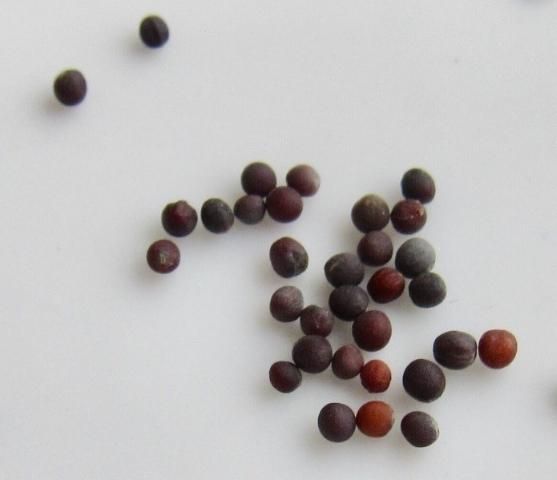
Credit: Jieli Qiao, Guiyang, Guizhou, China
Bok choy is rich in mineral nutrients and vitamins (Table 1). Regular consumption may benefit human cardiovascular health (Manchalia et al. 2012) because of its abundant crude fiber and riboflavin (Vitamin B2). Due to the rich content of retinol (Vitamin A1), bok choy may also have a beneficial effect in the remediation of vision problems such as cataracts, amaurosis, and macular degeneration (Thomason et al. 2010). Bok choy contains 1.4% dietary fiber and can minimize constipation as well (Manchalia et al. 2012).
How to Grow Bok Choy
With a wide temperature range of adaptation, bok choy can be grown in most areas of south Florida year-round. In north Florida, it can have two or three growing seasons per year. This crop prefers slightly acidic (pH 5.5 to 7.0) sandy soil rich in nutrients. Soil should be prepared according to EDIS publication HS503, Soil Preparation and Liming for Vegetable Gardens, at https://edis.ifas.ufl.edu/vh024 (Stephens and Liu 2016). The prepared land should be kept moist. At planting, seeds should be planted in rows 12 inches (30 cm) apart with 8-inch (20 cm) plant spacing (Figure 2–3). There is no UF/IFAS fertilizer recommendation available, but growers may use recommendations for other crucifers, such as broccoli or cabbage for the time being: 175 lb/acre (196 kg/ha) nitrogen; 120–150 and 100 lb/acre (134–168 and 112 kg/ha) phosphate pentoxide and potassium oxide for low and medium soil test index using the Mehlich 3 soil extractant method (Chapter 2 of the Vegetable Production Handbook of Florida, "Fertilizer Management for Vegetable Production in Florida," https://edis.ifas.ufl.edu/cv296, Liu et al. 2022). Usually, bok choy is harvested at the 10–15 leaf stage for regular leafy green production, while sometimes growers would keep them growing until mature stage (bolting stage) for seed production.
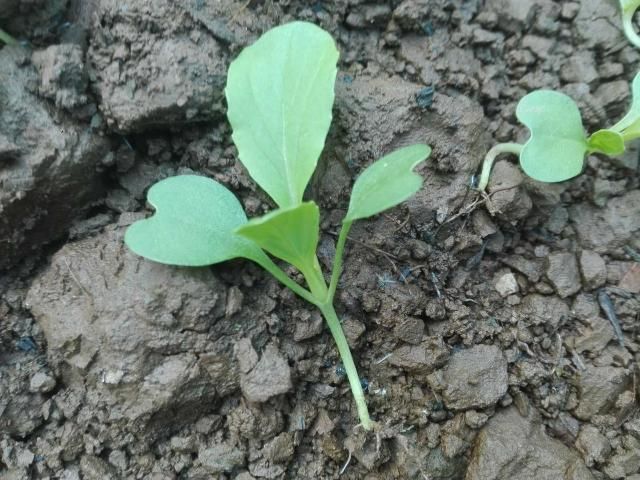
Credit: Jieli Qiao, Guiyang, Guizhou, China
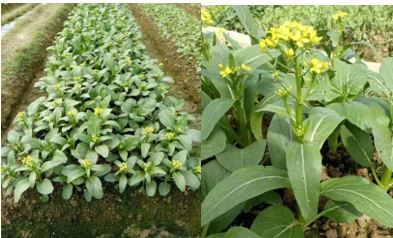
Credit: Fengchao Liu, Xiamen, Fujian, China
Disease and Pest Control
The main pests and diseases occurring on bok choy include leaf blight, downy mildew, aphids, and cabbage caterpillars. Leaf blight and downy mildew usually occur in summer with high temperatures and rain. To control pests and diseases, firstly, strengthen field management; and secondly, apply chemical pesticides or fungicides, such as bordeaux mixture and carbendazim. Spraying trichlorfon or dimethoate 40% EC (dimethoate 40% emulsifiable concentrate, a systemic and contact insecticide and miticide) can control aphids and cabbage caterpillars, which exist at every growth stage.
How to Harvest Bok Choy
Bok choy can normally be harvested 40–50 days after seeding. The plants can be harvested with 10 to 15 leaves by cutting from the soil surface and can then be cleaned and packed for sale. The harvesting date depends on the temperature, soil fertility, and moisture (Figure 4). If the vegetable is harvested too late (when it has more than 15 leaves), the taste will become a little bitter. Therefore, harvesting on time is critically important. Both one-time harvest for commercial production and multiple harvests by home gardeners may be practiced. For multiple harvests from the garden, plants that meet the 10-to-15-leaf stage should be selected, allowing smaller plants to continue growing.
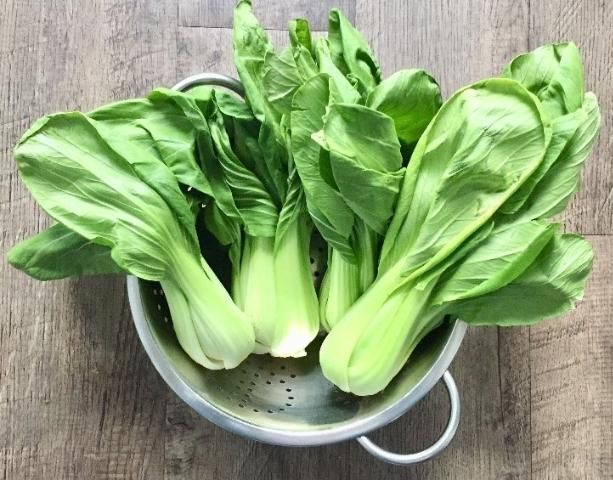
Credit: Jieli Qiao, Guiyang, Guizhou, China
How to Cook Bok Choy
Bok choy's low-calorie content makes it popular in the Chinese communities. Before cooking, the leaves should be individually washed to remove any soil or dirty things and chopped into pieces; then they are ready for cooking. Bok choy is often cooked by stir-frying alone or with some seasonings, such as pieces of fresh garlic or chili peppers (Figure 5). It can also be used in soup or as an instant-boiled vegetable in firepot or hotpot. Bok choy can be cooked with oyster sauce, mushroom, squid, or bacon as well to give different flavors.
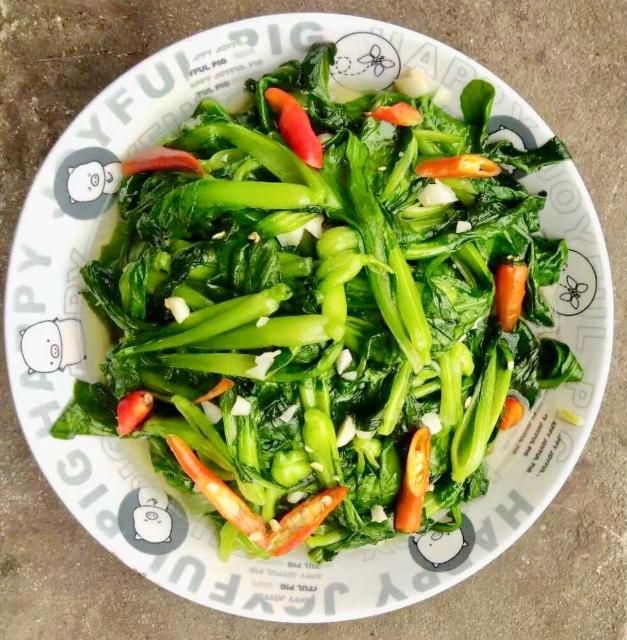
Credit: Jieli Qiao, Guiyang, Guizhou, China
References and Further Reading
Ashen, M. D. 2013. "Vegetarian Diets in Cardiovascular Prevention." Current Treatment Options in Cardiovascular Medicine 15(6): 735–745.
Chen, S. G. 2010. "High Yield Cultivation Technology of Bok Choy." Fujian Agricultural Science and Technology 40(1): 45–46.
Liu, G., E. H. Simonne, K. T. Morgan, G. J. Hochmuth, S. Agehara and R. Mylavarapu. 2022. Chapter 2. Fertilizer Management for Vegetable Production in Florida. CV296. Gainesville: University of Florida Institute of Food and Agricultural Sciences. https://edis.ifas.ufl.edu/cv296. Accessed on January 12, 2023.
Manchali, S., K. N. C. Murthy, and B. S. Patil. 2012. "Crucial Facts about Health Benefits of Popular Cruciferous Vegetables." Journal of Functional Foods 4(1): 94–106 https://www.sciencedirect.com/science/article/pii/S1756464611000843. Accessed on January 12, 2023.
Nair, A., and B. Havlovic. 2015. "Bok Choy Cultivars for High Tunnel Production." Iowa State Research Farm Progress Reports 2141. Ames: Iowa State University. http://lib.dr.iastate.edu/farms_reports/2141. Accessed on January 12, 2023.
Pan, X. L., and G. R. Liang. 2017. "High-Efficiency Cultivation Models of Cucumber, Shanghai Green and Tomato in Sunlight Greenhouse." Henan Agriculture (24): 46.
Shuler, K. D., S. J. Nie, and P. A. N. Shuler. 2001. "The Evolution of Production, Harvesting, and Marketing Techniques for Bok Choy." Proceedings of the Florida State Horticultural Society 114: 224–231.
Stephens, J., and G. D. Liu. 2022. Soil Preparation and Liming for Vegetable Gardens. HS503. Gainesville: University of Florida Institute of Food and Agricultural Sciences. https://edis.ifas.ufl.edu/vh024. Accessed on January 12, 2023.
Thomson C. A., S. Dickinson, and G. T. Bowden. 2010. "Cruciferous Vegetables, Isothiocyanates, Indoles, and Cancer Prevention." In: Bioactive Compounds and Cancer. Nutrition and Health, edited by J. A. Milner and D. F. Romagnolo. 535–566. Humana Press, Totowa, N.J. https://link.springer.com/chapter/10.1007/978-1-60761-627-6_23. Accessed on January 12, 2023.
USDA-ARS. 2018. "National Nutrient Database for Standard Reference Legacy Release, Full Report (All Nutrients): 11116, Cabbage, chinese (pak-choi), raw." https://www.urmc.rochester.edu/encyclopedia/content.aspx?contenttypeid=76&contentid=11116-3. Accessed on January 12, 2023.
Zhang, X., X. O. Shu, Y. B. Xiang, G. Yang, H. Li, J. Gao, H. Cai, Y. T. Gao, and W. Zheng. 2011. "Cruciferous Vegetable Consumption Is Associated with a Reduced Risk of Total and Cardiovascular Disease Mortality." The American Journal of Clinical Nutrition 94(1): 240–246.